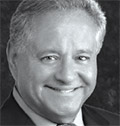Despite the category’s small share (about 10 percent) of the contact lens market, exciting things are happening with gas permeable (GP) lenses, which are popular with people who have dry eyes, folks who cannot wear soft lenses, or who have had problems with Lasik surgery. Demand for corneal GP lenses (still the largest subcategory) is on the wane, but the market for scleral and orthokeratology (Ortho-K) is on the rise, say several GP lens manufacturers. In the past year, ABB Optical Group has seen a 142 percent increase in the number of scleral lens units sold and a 35 percent boost in unit sales of Ortho-K lenses.
A scleral lens is large enough to stay in place for irregular corneas (keratoconus), while Ortho-K lenses can temporarily reshape the cornea (usually overnight) in order to correct myopia. “GP lenses have patient following because they don’t need to be replaced so frequently, they are cheaper and easier to take care of,” explains Jan Svochak, president of the Contact Lens Manufacturers Association. “The scleral lens in particular is medically necessary for some patients and that’s why there’s interest now in manufacturing it.”
Josh Adams of Valley Contax says big pharmaceutical companies want to get into this space because of the growth of Ortho-K and scleral lenses, noting, “They look at the manufacturing costs of each blank and they see how they can make money from these finished lenses.”
Scleral lenses are “an old idea with a new technology,” says Jean Blanchard of Blanchard Contact Lens, with updated rigid materials that allow oxygen to flow through the lens to the cornea. “I think ECPs need to recognize the advantages these lenses can offer their patients,” he adds. “They can literally be a life-changing device. They can allow someone to regain their sight to drive a car or help a young athlete with astigmatism play baseball again.” — CAROL GILHAWLEY
This article originally appeared in the February 2016 edition of INVISION.

Advertisement
Smart Ways to Sell More
Gas Permeable Lenses

DR. STEPHEN COHEN
Doctor My Eyes, Scottsdale, AZ
Advertisement
➤ GP multifocal designs can be very effective for patients with stigmatism as they provide superior clarity. The lens lasts longer than a soft lens, vision is crisp and care is minimal. Although technology and the industry are moving toward daily disposable lenses, there is an excellent market for GP lenses because they allow for greater customization. A patient is more likely to get a GP lens fitted by a prescribing doctor than take that Rx and get it fabricated elsewhere. ECPs can also command a premium fee for the lens and their time and expertise in fitting it. We’ve been having a lot of success fitting scleral lenses and have positioned it in our office like our corneal refractive therapy fittings. If practitioners have optical coherence tomography in the office, this can play a very beneficial role in fitting a scleral lens.

LYNDA BAKER
ABB Optical Group
➤ Doctors need to learn how to fit these lenses but once a doctor has fit a scleral lens, which on average is 16.5 mm in diameter, then they have become a GP fitter. We design these lenses so we know what lens to send the eyecare practitioner. Some lens designs require doctors to be certified and lab consultants can help them with certification and fitting the lenses.

Advertisement
JOSH ADAMS
Valley Contax
➤ There are good margins on Ortho-K and the scleral lens is a good business model so they have the potential to be profitable. We say scleral lens fitting is easy and you don’t have to be an expert or charge thousands of dollars for it. We’re reinventing the scleral lens and we’re investing in it long-term. We’re working with optometry schools to educate students. We’ve already given 1,000 scleral lens fitting sets to optometry graduates. We’re changing the culture of GP lenses with the next generation of ODs by doing sponsored workshops.